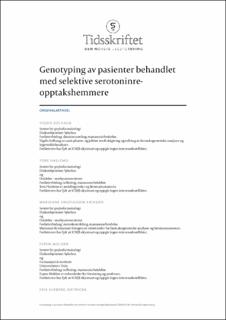| dc.contributor.author | Solhaug, Vigdis | |
| dc.contributor.author | Haslemo, Tore | |
| dc.contributor.author | Kringen, Marianne Kristiansen | |
| dc.contributor.author | Molden, Espen | |
| dc.contributor.author | Dietrichs, Erik Sveberg | |
| dc.date.accessioned | 2022-12-23T11:17:57Z | |
| dc.date.available | 2022-12-23T11:17:57Z | |
| dc.date.created | 2022-09-26T21:47:37Z | |
| dc.date.issued | 2022-09-26 | |
| dc.identifier.citation | Tidsskrift for Den norske legeforening. 2022, 142 (13), 1-10. | en_US |
| dc.identifier.issn | 0029-2001 | |
| dc.identifier.issn | 0807-7096 | |
| dc.identifier.uri | https://hdl.handle.net/11250/3039380 | |
| dc.description.abstract | Bakgrunn: Selektive serotoninreopptakshemmere (SSRI) brukes av over 180 000 mennesker i Norge. Enzymene CYP2D6 og CYP2C19 er sentrale i metabolismen av SSRI-antidepressiver. Serotonintransportøren kodet av SLC6A4 kan ha betydning for effekten av medikamentene.
Materiale og metode: Alle pasienter som hadde blitt genotypet for CYP2D6, CYP2C19 og SLC6A4 ved Senter for psykofarmakologi i 2020, uavhengig av indikasjon, ble inkludert. Hos de pasientene der data var tilgjengelige, ble CYP2C19-genotype koblet til serumkonsentrasjonsmåling av escitalopram, som er det mest brukte SSRI-preparatet.
Resultater: 432 av 3 492 pasienter (12,4 %) hadde en kombinasjon av genotyper av CYP2D6, CYP2C19 og SLC6A4 som anses å gi mest gunstig metabolisme og effekt av SSRI-antidepressiver. Pasienter med manglende CYP2C19-metabolisme hadde mer enn halvert dosebehov for å oppnå samme konsentrasjon av escitalopram som pasienter med normal metabolisme.
Fortolkning: Våre funn viser lav forekomst av den gunstigste genotypekombinasjonen for respons av SSRI-preparater. Genotypekombinasjoner bidrar sannsynligvis til den store individuelle variasjonen i effekt av disse medikamentene og til at behandlingen ikke gir ønsket utfall hos mange pasienter.
Background: Selective serotonin reuptake inhibitors (SSRIs) are used by over 180,000 people in Norway. The enzymes CYP2D6 and CYP2C19 are key in the metabolism of SSRI antidepressants. The serotonin transporter coded by SLC6A4 may be significant for the efficacy of the drugs.
Material and method: All patients who had undergone genotyping for CYP2D6, CYP2C19 and SLC6A4 at the Centre for Psychopharmacology in 2020 were included, irrespective of indication. For those patients where data were available, CYP2C19 genotype was linked to serum concentration measurement of escitalopram, which is the most commonly used SSRI drug.
Results: Out of 3,492 patients, 432 (12.4 %) had a combination of genotypes of CYP2D6, CYP2C19 and SLC6A4 considered to lead to the most favourable metabolism and efficacy of SSRI antidepressants. The dose requirement in patients with poor CYP2C19 metabolism was more than halved to achieve the same concentration of escitalopram compared to patients with normal metabolism.
Interpretation: Our findings demonstrate the low prevalence of the most favourable genotype combination for response to SSRIs. Genotype combinations probably contribute to the wide variation between individuals in the efficacy of these drugs and the fact that treatment does not produce the desired outcome in many patients. | en_US |
| dc.language.iso | nob | en_US |
| dc.publisher | Den norske legeforening | en_US |
| dc.relation.ispartofseries | Tidsskrift for Den norske legeforening;Utgave 13/2022 – Årgang 142 | |
| dc.rights | Attribution-NoDerivatives 4.0 Internasjonal | * |
| dc.rights.uri | http://creativecommons.org/licenses/by-nd/4.0/deed.no | * |
| dc.subject | Selektive serotoninreopptakshemmere | en_US |
| dc.subject | Serotonin | en_US |
| dc.subject | Genotyper | en_US |
| dc.subject | Metabolisme | en_US |
| dc.subject | SSRI-preparater | en_US |
| dc.subject | Medikamentell behandling | en_US |
| dc.title | Genotyping av pasienter behandlet med selektive serotoninreopptakshemmere | en_US |
| dc.title.alternative | Genotyping of patients treated with selective serotonin reuptake inhibitors | en_US |
| dc.type | Peer reviewed | en_US |
| dc.type | Journal article | en_US |
| dc.description.version | publishedVersion | en_US |
| cristin.ispublished | true | |
| cristin.fulltext | original | |
| cristin.qualitycode | 1 | |
| dc.identifier.doi | https://doi.org/10.4045/tidsskr.22.0017 | |
| dc.identifier.cristin | 2055696 | |
| dc.source.journal | Tidsskrift for Den norske legeforening | en_US |
| dc.source.volume | 142 | en_US |
| dc.source.issue | 13 | en_US |
| dc.source.pagenumber | 1140-1145 | en_US |

